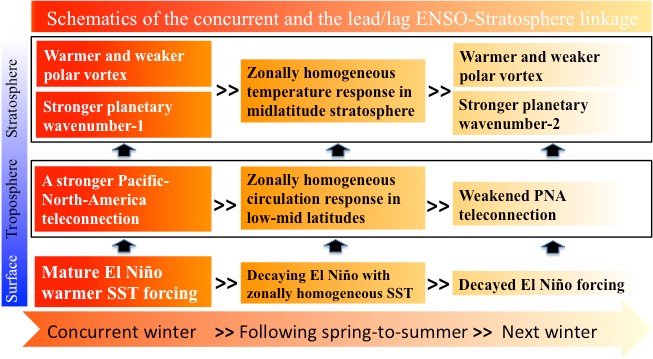ENSO is known to have significant effects in the extratropical stratosphere when it matures in winter, because ENSO can largely modulate the circulation patterns in the troposphere and influence the upward propagation of planetary waves into the extratropical stratosphere. The stratospheric polar vortex and the circumpolar westerly jet tend to be anomalously weaker/stronger during El Niño/La Niña winters. Later on in spring-to-summer of ENSO decay years, ENSO’s delayed effects in the troposphere are also found and they are critical for the circulation and climate anomalies across the globe. However, we still don’t know whether ENSO can have a delayed effect in the stratosphere.
Recently, Prof. REN Rongcai, Dr. RAO Jian (currently working in Nanjing University of Information Science and Technology) and their coauthors have identified the robust existence of ENSO’s delayed effects in stratosphere in the next winter after mature ENSO phase, based on multi-reanalysis datasets, CMIP5 model simulations and sensitivity experiments.

Schematics of the concurrent and the lead/lag ENSO-Stratosphere linkage (Image by REN Rongcai)
Their results show that, except for those quick-decaying quasi-biennial (QB) ENSO events that reverse signs during July−August−September (JAS) in their decay years, other ENSO events, particularly those quasi-quadrennial (QQ) that persist through JAS, always have significant effects in the extratropical stratosphere in both the concurrent winter and the next winter following mature ENSO. Though ENSO is decaying in spring-summer, the tropical Sea Surface Temperature (SST) forcing becomes zonally quasi homogeneous due to the delayed SST responses in the Indian Ocean and the Atlantic. Associated are zonally quasi homogeneous temperature anomalies in the midlatitudes from the troposphere to the stratosphere. Till the next winter, there appear anomalous stronger meridional heat/mass transport with the increasing of planetary-wave activities, and therefore the one-year delayed polar vortex anomalies in the stratosphere (see the schematics).
"In general, it is the delayed SST and atmospheric responses in troposphere in the lower latitudes to ENSO, that are crucial for the existence of the one-year delayed ENSO-stratosphere linkage.” Said Ren. The series of studies are published in Climate Dynamics in 2012 and 2017.
Reference:
Ren R-C., J Rao, G .X. Wu and M. Cai, 2017: Tracking the delayed response of the northern winter stratosphere to ENSO using multi reanalyses and model simulations, Climate Dynamics, 48(9), 2859-2879, DOI: 10.1007/s00382-016-3238-9.
Ren, R.-C., M. Cai, C. Xiang and G. Wu, 2012: Observational evidence of the delayed response of stratospheric polar vortex variability to ENSO SST anomalies. Climate Dyn. , 38(7), 1345-1358, DOI: 10.1007/s00382-011-1137-7.
Contact: REN Rongcai, rrc@lasg.iap.ac.cn
